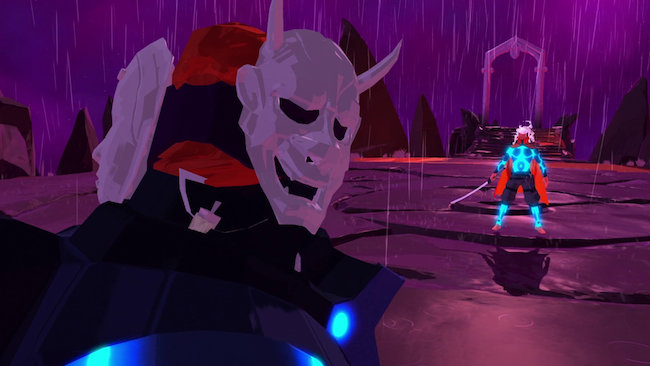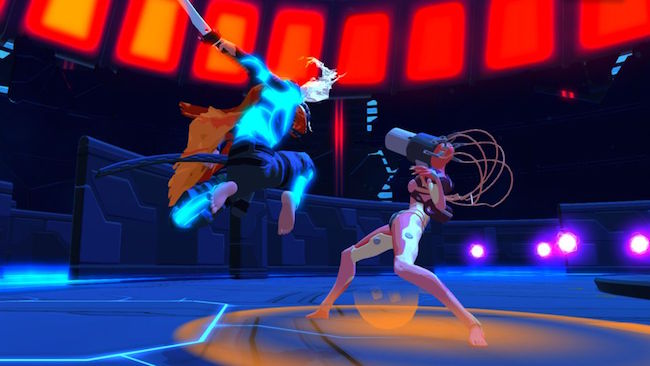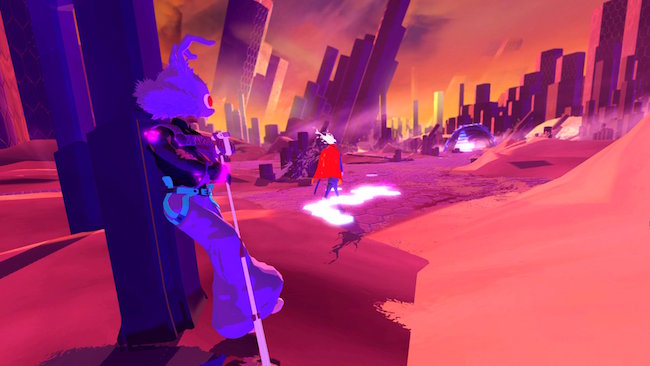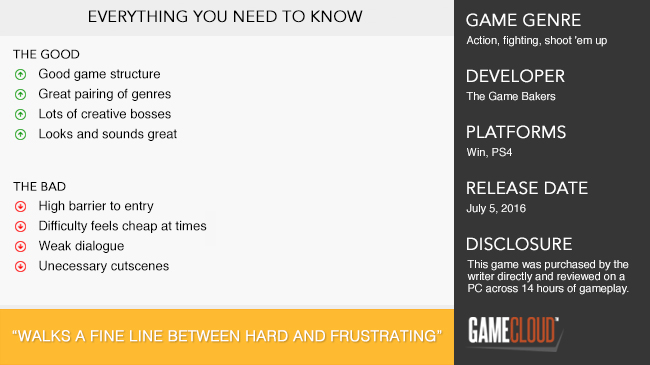
When combining genres, mixing Character Action and Shoot ‘em ups together seems like an odd combination as well as a very ambitious task. However, the Game Bakers took on this challenge and managed to execute a challenging bullet hell style game with tight melee swordplay. Teaming up with Afro-Samurai designer, Takashi Okazaki to realise their vision, the end product, Furi, is a great looking game with some very intense yet solid combat.
As far as a story goes, Furi has a relatively straightforward narrative. Furthermore, the narrative is closely coupled with the structure of the game’s design. You play as a character known as The Stranger who escapes from some sort of prison. Freedom lays beyond a series of boss battles, each with their own unique characteristics.
In terms of character development, there really isn’t a whole lot to look at seeing as the developer’s efforts were primarily focused on delivering polished combat. Unfortunately, too, most of the story elements are awkwardly placed within the game. For example, weak dialogue as well as cutscenes between each boss encounter that fail to match the overall pace of the game. Honestly, the cutscenes are more often frustrating than informative, so I feel the narrative would have been much better off had it acted solely as a vessel for the structure that the game was designed around.

To progress means fighting bosses. There is no fodder in between and no exploration, just arena boss battles. Each boss is distinct and equipped with a brilliant arsenal that is very well designed. These original designs also mean that your time spent playing Furi is mostly allocated to learning a boss’ behaviour and developing strategies on how to defeat each one – throwing yourself countless times at your enemy until you find a way to break each one down.
Every boss has multiple states they’ll transition between when you completely deplete a HP bar. When swapping to a new state, the enemy will behave differently – usually alternating between the hack/slash and shoot ‘em up elements of the game. It is in these states where the game’s challenge resides, and where the game walks a fine line between challenging and frustrating. Losing a life will push you back a state as well as significantly hinder your progress. It can take an excessive amount of time to get back to where you were, so some fights will run much longer than desired.

Despite the game’s competent design, the developers tend use difficulty as a crutch – often mistaking a difficult game for a well-designed one. I can’t help but feel those not familiar with the genres incorporated in Furi will find the game more frustrating than anything. Lowering the difficulty provides a drastically different game where most of the enemy states are omitted thus robbing players of much of the well-designed enemies. Sadly, there’s no happy middle ground.
Solid gameplay is essential to pull off this style of game (in either genre), and fortunately, The Game Bakers stepped up to execute this component very well for the most part. As far as melee combat goes, the player has a three strike combo: charge attack, dodge, and a parry. Combat is fast and responsive, and the player’s arsenal, though static, can be used in a wide variety of ways. Combos are relatively limited, although due to the game’s pacing it is understandable that developers chose to stick to a three phase combo. The charge attack can only be successful at opportune moments, but is very satisfying once it hits. It also gives players the opportunity to execute high damage moves, which each have a different animation for every boss and boss state.

Learning to parry effectively is essential to the game too. However, I was left feeling somewhat cheated trying to land a good parry as executing one on the frame of the visual cue is already too late so the player has to anticipate enemy attacks as opposed to reacting to them. Range combat is where the shoot ‘em up elements usually take place. Armed with a gun with a rapid shot and a charge shot, the player faces a bullet hell style number of projectiles and has to dodge and sneak in shots at the boss. Each boss has their own shooting pattern and behaviours that are very distinct for each one, keeping players on their toes and adapting to the various boss styles and attack arsenals.
Furi’s striking visuals are definitely one of the more enticing elements of the game. With its low poly art style coupled with a very vibrant colour scheme, this game manages to look somewhat beautiful while still keeping a manageable frame rate necessary for the intense combat. Each boss is a fresh design and character himself is presented quite well as neon lights flash within him during different states of combat. As the screen floods with elements when enemies fire multiple projectiles at you, the neon pallet does well not to make a mess of the screen and keep the game looking great. The soundtrack also does a great job fitting in seamlessly with each fight, where at times it even felt like I was taking reflex shots at the enemies in time to the beat of the background music.

Given the genres The Game Bakers chose to commit to with Furi, they would have done well to lean more into an arcade style game structure. The game itself is difficult yet satisfying, however with such a high barrier to entry I can only see those familiar with the genre really enjoying this game. With no metrics or score system, not a whole lot would incentivise me to replay this game as it too often walks a fine line between challenging and frustrating.











